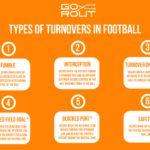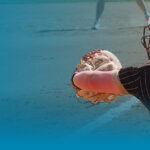7 on 7 Football: A Comprehensive Guide
Reading Time: 9 minutes
Reading Time: 9 minutes
7 on 7 football has increased in popularity across the United States, especially among youth leagues like Pop Warner that have adopted modified versions of the game to provide early skill development opportunities.
This fast-paced version of America’s favorite sport gives wide receivers and defensive backs a high volume of reps against each other and quarterbacks the chance to work on accuracy.
7 on 7 football is played on a smaller field with fewer players, putting skill positions at the forefront and creating an action-packed contest filled with big plays.
In this article, we will help you learn more about this concept and its various benefits, explain how to organize a 7 on 7 football team and show you how to implement GoRout, our leading coach-to-player communication system, in your football practice to enhance players’ performance on the field.
Let’s get started.
The fundamentals of 7 on 7 football
7 on 7 football, also known as 7v7 football, is a non-contact variation of the classic American football game.
Basic rules and regulations
Each team consists of seven players on offense, including a quarterback, running backs, wide receivers and tight ends, and seven on defense, including cornerbacks, safeties, and linebackers.
The gameplay focuses on the passing game and strongly emphasizes running routes. So much so that running plays are not allowed at all.
Team objectives are the same as in regulation football. While the end goal for the offense is to score a touchdown, first downs are gained by crossing the 25 and 10-yard lines. Defenses try to stop drives by forcing a turnover on downs, making an interception, or recovering a fumble.
There is no tackling in this game, and players wear no pads. Players are considered “down” if defensive players touch them with one or two hands below the neck, similar to touch football. Some game versions require players to wear flags on their belts, with the player being “down” if a defender pulls down one of the flags or the whole belt.
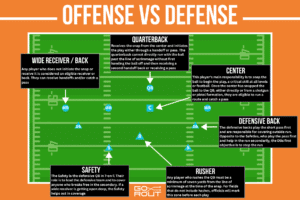
Scoring is similar to traditional football. Touchdowns are worth 6 points, extra point kicks are taken from the 3-yard line, and teams can opt for 2-point conversions from the 10-yard line. The clock runs mostly continuously, and halves are 12-15 minutes long.
Key differences from traditional football
Here are some important distinctions between traditional American football and 7 on 7 football:
- Team size: 7 on 7 football is played with seven players, while traditional American football has 11 players on each team.
- No linemen: In 7 on 7, there are no offensive or defensive linemen.
- Passing focus: With fewer players on the field and no pass rush, 7 on 7 football emphasizes passing. Teams pass almost every down, which helps quarterbacks, receivers, and defensive backs develop their skills in the passing game.
- Rules: Leagues and tournaments may have specific rules related to first downs, punting, and overtime to adapt the traditional American football rules to the 7 on 7 format.
- Competition level: 7v7 football is a practice concept used regularly by many football teams. It can also be played recreationally in a tournament style.
Now that we covered the basics, let’s explain the advantages of 7 on 7 football.
Benefits of 7 on 7 football for player development
Here are the most important advantages for player development, 7v7 football has to offer.
Improved passing and receiving skills
The game is primarily focused on passing, which gives quarterbacks and receivers ample opportunities to practice throwing, receiving, and securing the ball.
These constant repetitions help improve their timing, route precision, catch radius, and overall chemistry in the air. The majority of the 7 on 7 game involves players handling and moving the ball through the air, which further enhances their position-specific skills.
Enhanced quarterback decision-making
Quarterbacks are made to lead drives through the air, making sound play calls and getting the ball out ahead of the pass rush. This helps them to learn to read the coverages of opposing defenses and exploit their weaknesses.
In 7 on 7 quarterback decision-making, they are required to find receivers and react quickly based on their reading of the opposing team’s defense. To be successful, they must be able to make a variety of throws accurately under pressure.
Increased defensive awareness and coverage skills
By testing their coverage skills at such a high volume, defensive backs gain increased comfort in pass protection and log a lot of situational repetitions.
Speed and agility training
By removing extra physical contact, players, and other elements from the traditional game, there is a wider field for fast movements and offensive plays.
This open space allows players to focus on sharpening their acceleration, applying top speed over shorter distances of 10-20 yards, and improving their change of direction capabilities, reaction times, and physical and mental processing speed for plays.
Planning and organizing a 7 on 7 football team
Successfully building a competitive 7v7 football team requires more than just gathering talent. It demands proper planning, structure, and organization from the coaches.
Team composition
The first step in putting together a competitive team is to find the right players for an offense and defense built to air it out. As a coach, you should identify kids that fit the fast-paced, high-flying style of play.
For the offense, look for speedy playmakers like receivers who run crisp routes and have great hands and running back/tight end hybrid types that can catch well out of the backfield. You also need an accurate passer at quarterback who makes quick reads.
On defense, prioritize lockdown corners and ball-hawking safeties, while linebackers need the athleticism to contain cat-quick slot receivers.
Don’t overload on just receivers and defensive backs; find multi-dimensional players across positions who excel in space and can pull double duty if needed. Balance and versatility keep the team clicking.
Most importantly, position your players based on their size and defensive assignments. Bigger kids can clog the middle, while smaller speedsters operate on the outside.
Coaching staff roles and responsibilities
As head coach, manage the offensive and defensive game plans and call plays to your players’ strengths. Including a defensive coordinator on your staff will free you up to focus on installing passing schemes. Coordinators handle their units in practice and can independently make adjustments between games.
Appoint position coaches to refine techniques for quarterback, receivers, defensive backs, and other position groups. A QB coach improves throwing mechanics and reading defenses.
A DB specialist teaches advanced coverage skills. Players improve rapidly in aerial roles with coordinators and position coaches tailoring training.
Practice structure and drills
To begin each 7v7 practice, activating muscles through dynamic stretches and high-energy movements is essential. It’s crucial to dedicate some time for receivers to perfect their route-running techniques in isolation before facing defensive coverage.
Gradually blend individual work into full seven-on-sevens with man coverage pressure to simulate live game reps. Incorporate situational hurry-up offense periods to build endurance. Finally, conclude the practice by allowing muscles to cool down through light static stretching.
Another key aspect of the practice should be to work on football drills and ball skill exercises that help improve players’ change-of-direction ability, hands, and body control. It’s vital to constantly connect all the training back to tightening QB/receiver chemistry, essential for orchestrating the fast-paced aerial attack.
Implementing technological advancements in coaching
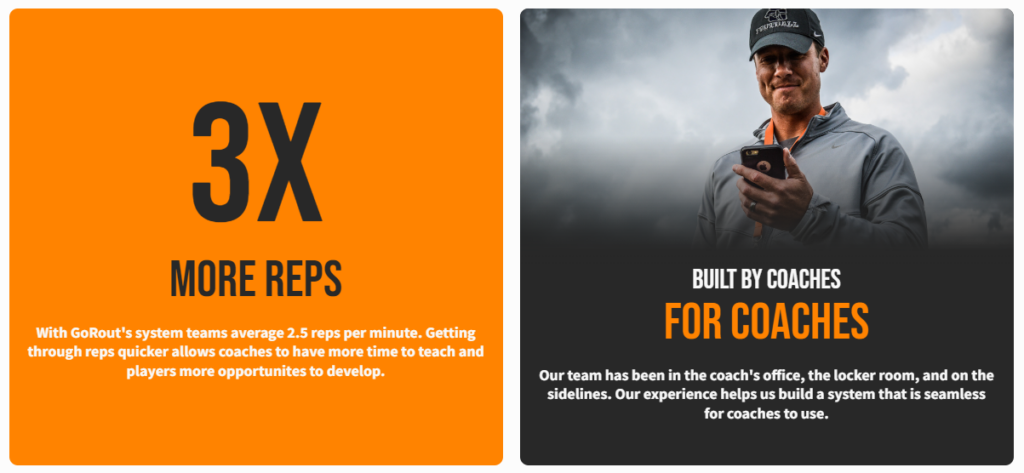
Sports technology can take your practice to the next level.
GoRout is our premier football play-calling system that equips you with apps and devices to optimize practice time, facilitate team communication, and unlock your players’ full potential on game day.
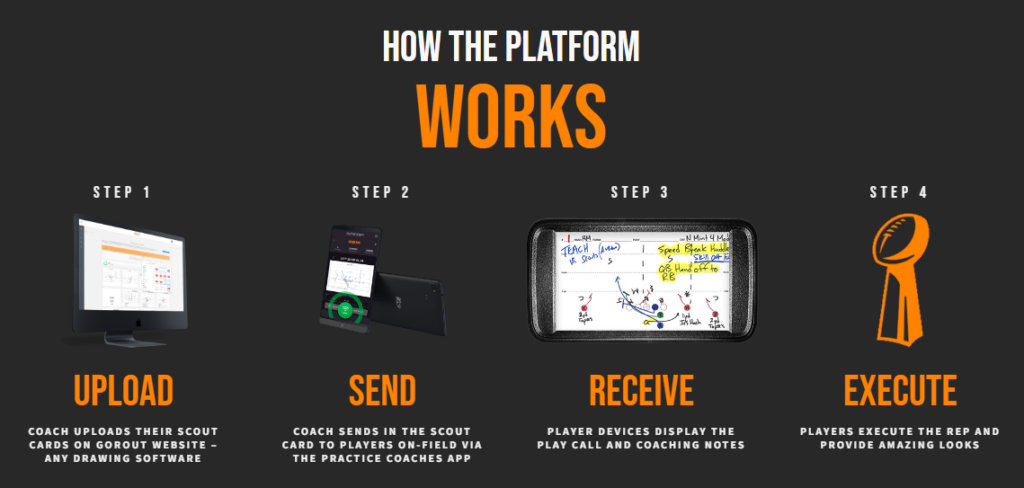
Our football coaching software empowers teams to average 2.5 reps per minute, freeing valuable coaching time and granting players unmatched practice opportunities to hone their skills and reach their peak performance.
Let’s explain how.
GoRout scripting app

GoRout empowers you to adapt your practice plan on the fly. With simple copy, move, and flip functions, you can effortlessly adjust plays between periods, ensuring your practice remains dynamic.
GoRout works seamlessly with Google Chrome, making your practice plans accessible from any device. You can easily access and update your scripts at the field or on the go.
It helps you focus more on developing your team’s skills and achieving success.
GoRout on-field practice app

GoRout on-field practice app improves the overall coaching experience by helping coaches streamline practice management and improve player communication:
- Effortless formation changes: Forget wasting time manually flipping cards. GoRout allows for instant formation changes with a single tap, keeping players focused and practice flowing smoothly.
- Seamless play review: Identify areas for improvement quickly and easily. Flag plays for review with a single touch, allowing immediate adjustments and targeted feedback for your players.
- Real-time play editing: Remain adaptable and responsive to changing situations. GoRout lets you draw directly on the screen to edit plays on the fly, ensuring your practice plan is always dynamic and relevant.
- Streamlined practice flow: Organize practice sessions with ease. Start, end, and manage drills directly within the app, minimizing distractions and maximizing practice efficiency.
- Enhanced player communication: Ensure everyone is on the same page with crystal-clear play delivery. Send plays directly to players’ devices, eliminating confusion and facilitating efficient execution.
GoRout goes beyond just providing features. With its user-friendly interface, platform compatibility, and time-saving features, GoRout allows you to focus on what truly matters: guiding your players to achieve their full potential.
Check out our youth football playbook.
Player devices

GoRout, as a leader in wearable technology for sports, helps coaches communicate effectively with players using special devices during practices and games.
Simply select your practice group on each device, and players will be ready to receive plays. Vibrations alert them to new plays, ensuring everyone’s on the same page. There is no setup or Wi-Fi required.
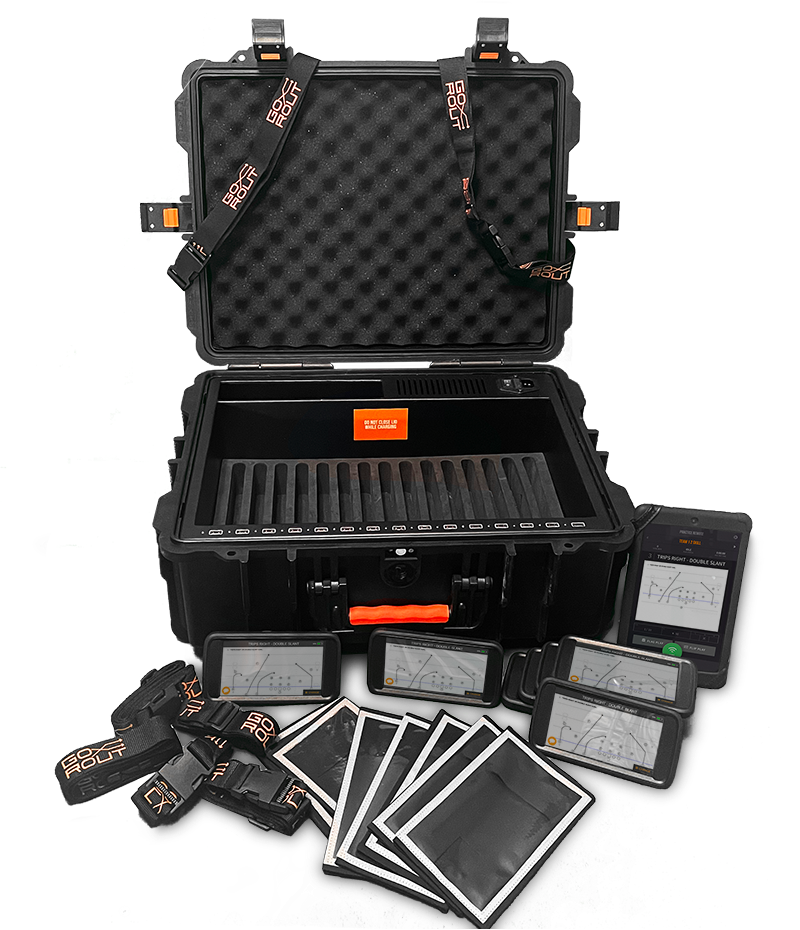
Here’s how you can streamline your practice with GoRout wearable devices:
- Run more plays with scout teams
- Elevate walkthroughs and drills
- Fuel fast-paced 7 on 7 sessions
- Master special teams plays (KO, KOR, P, PR)
- Prepare for up-tempo opponents
- Reduce install time for new players
GoRout devices display play drawings, position-specific messaging and other essential information, helping players stay informed and perform at their peak.
Tips and strategies for success in 7 on 7 Football
Success in 7 on 7 football requires consistent practice and effective execution.
Football coaching software can simplify game plans and enable you to call plays customized to your team’s strengths, improving performance and communication.
To succeed in 7 on 7, your team should concentrate on the following primary offensive and defensive strategies.
Offensive strategies
- Quick Passes
Use route combinations that give the quarterback short, quick throws to build confidence and move the chains. - Spread Formation
Align with three or four receivers that force defenses to declare coverage responsibilities. This will force more one-on-one opportunities for yards after the catch. - Speed Strategies
Call plays like jet sweeps, end-arounds, and screens that allow pass catchers to use their speed in space.
Defensive strategies
- Zone Coverage
Pattern reading to identify receivers entering and leaving assigned coverage areas. - Man Coverage
Bumping and pressing coverage at the line to disrupt timing. - Blitzing
Use safety and corner blitz to apply unexpected pressure on the quarterback. - Turnovers
Coach players to always be ready for a chance to strip the ball during a tackle or catch a tipped ball or errant pass.
Safety considerations in 7 on 7 football
Football is a high-intensity and high-contact sport that can lead to severe injuries if players are not taught proper technique. 7 on 7 football is no exception. In this sport, players are exposed to a fast-paced and open-field environment, which increases the risk of injury.
Therefore, coaches and players must prioritize safety considerations to prevent injuries and ensure everyone can enjoy the game without risks.
Injury prevention techniques
To prevent injuries, coaches must focus on injury prevention techniques, avoiding helmet-to-helmet contact, and changing direction without overextending joints.
Additionally, coaches should encourage preventative measures such as taping ankles and wearing knee braces.
Monitoring player workload
Due to smaller team sizes, 7 on 7 players often play at full speed for extended periods during tournaments. Coaches must actively monitor each athlete’s snap count and substitutions to ensure excessive fatigue does not lead to injury.
Pitch counts for quarterbacks and limits on repetitive sprint distance for receivers are examples of workload management.
Protecting players’ health is critical, and proper conditioning, position rotation, and providing adequate rest during multi-day tournaments can help reduce the risk of injury.
Ensuring proper equipment
The safety of players depends heavily on access to top-quality equipment and well-maintained fields. Coaches should choose helmets with the latest anti-concussion padding and cleats that provide proper traction for route running and change of direction.
Fields also need consistent maintenance without holes, uneven turf, or debris that could contribute to falls or twisting injuries. Coaches are responsible for conducting safety checks and advocating for proper investment into equipment and facilities for their programs.
Conclusion about 7 on 7 football
7 on 7 football is an adaptation of traditional football that focuses on the passing game and is played with just seven players per team on the field. This faster-paced version allows for increased reps and development for quarterbacks, receivers, and defensive backs.
The wide-open format and lack of contact allow players to refine their route running, ball skills, athletic abilities, decision-making, and chemistry between passers and pass catchers.
Coaches may consider integrating 7 on 7 concepts like spread formations and pass-heavy play calling into their practices to prepare players for live games.
To improve performance further, you can use GoRout, built by coaches for coaches, as one of the best trends in sports.
Our solution is compatible with iPhone, iPad, and Android devices and features a user-friendly interface that makes it easy to start practicing without any setup or learning curve.
The GoRout system is designed to endure various weather conditions, such as high heat, humidity, snow, and rain. Every GoRout device is 100% warrantied against breakage, protecting players and equipment.
With its intuitive design, rugged devices, and real-time communication features, GoRout helps you save time, improve efficiency, and maximize player performance.
Get a quote now to see how GoRout can benefit your team!

